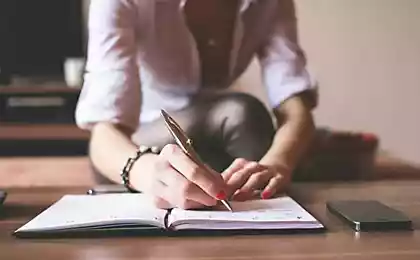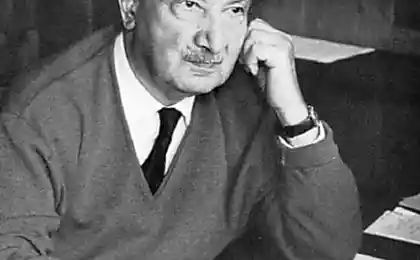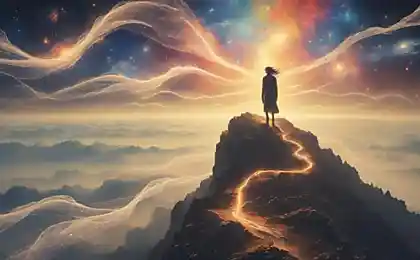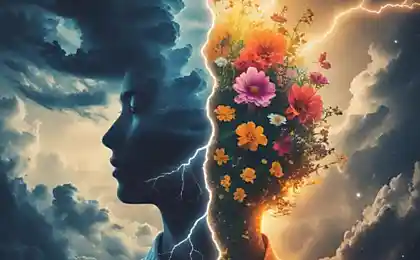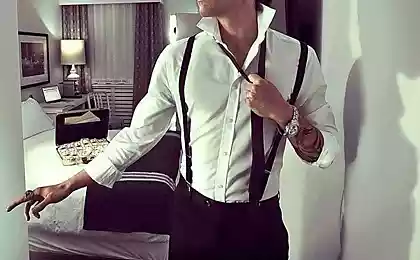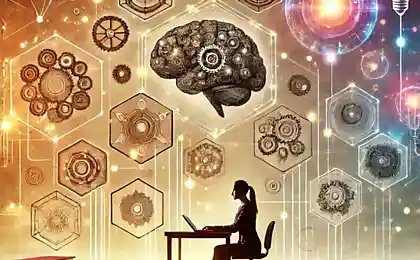602
The theory of unconscious thinking: how we make decisions
Experiments Dijksterhuis
Imagine you moved to a new city and you need to look for housing. The real estate agent offers you a choice of four apartments. They are different in the parameters – something more, something cheaper somewhere dear master, where is the bathroom with marble... options are many... and you need to make a decision.

It is this experience set Up Dijksterhuis from the University of Amsterdam. He gave the subjects all the data and asked to make a decision. The task was the right answer – selection criteria was well-known and one of the apartments was better than others.
The subjects were divided into three groups. The first group was asked to make a decision immediately without thinking. The second group were given time to think. And the last group exactly the same time distracted, not allowing them to reflect on the task. It was believed that this would enable them to form an honest unconscious decision.

Here are the results. Those who took the decision spontaneously turned out to be right 36% of the time is more than case (25%). Those who thought, showed significantly better results. But even the best results showed those who did NOT THINK! How did it happen?
The experiments were repeated several times in different conditions and the results of this study now make up what Dijksterhuis calls the theory of unconscious thinking. According to this theory, decisions made unconsciously, are the most qualitative in the most difficult situations.
Unconscious not able to give precise numerical answers to questions is a function of conscious. But it copes with the weighing of a large number of factors with different values – i.e. what we often have to do when deciding. He needs time – don't-think 2-minute show markedly worse results than not-think 7 minutes. It does not work without order if the test is not to say that they will ask the answer to the question, the quality will be very low.
The unconscious decisions people like. In experiments where participants chose for themselves reproductions which later was asked to sell, choosing unconsciously asked for their reproduction in 2 times more. But the host of a conscious decision more confident in the correctness of their decisions. They can be logically justified. The problem is that with the growth of complexity, they are increasingly wrong.
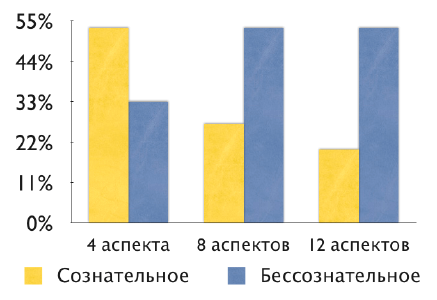
This diagram shows the choice of machine depending on the number of parameters. On simple tasks, the mind works well. But the more parameters, the worse cope consciousness. The unconscious, the increase in complexity does not interfere. Why? Yes, because its a lot more.
Conscious and unconscious
Where lies the distinction between the conscious and unconscious decision? Daniel Kahneman, psychologist, Nobel laureate in Economics and author of the theory of bounded rationality describes the relationship of the conscious and the unconscious:
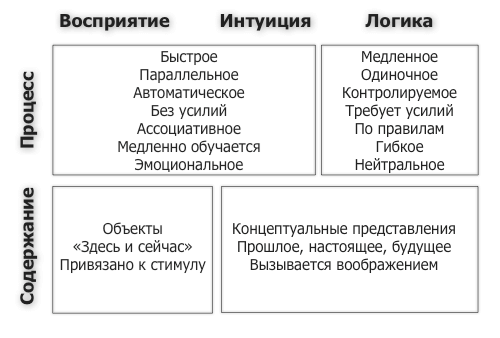
I know that this table is too much information, more than 7±2. So you have a bit dazzled. I want to focus your attention on the words “automatic” and “effortless”. It seems to me that in these words is the main attraction of unconscious decisions. There is no effort! No need to do anything. Later, however, it turns out that it's incredibly difficult to do nothing. Because the consciousness-that is, it needs to be put somewhere.
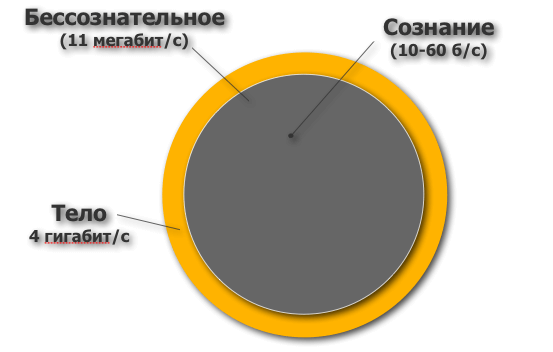
In cognitive neuroscience it is believed that the conscious is able to process approximately 10-60 bytes per second, and the ability of the nervous system evaluated as 11,200,000 bytes / sec. At the same time, through the senses: sight, hearing, the skin is the largest sensory organ, every second about 4 billion bits of information – but it is for the most part is eliminated. Our feeble brain is simply not able to process it all.
The picture above showing the relationship between the conscious and the unconscious, has a completely incorrect scale. In fact, consciousness is even less, I just don't have the screen to show correctly. If the scheme I outlined the conscious one pixel, then the unconscious will I need to draw a circle with a diameter of more than a million pixels. Such displays are not yet doing.
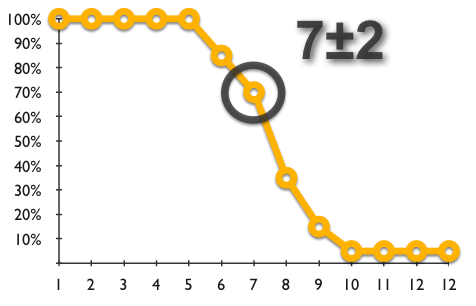
Consciousness is very small. Psychologists say that it is only 7±2 units. Have you ever heard about this number? “The magic number 7±2: or some of our limits on information processing” was the title of the article George Miller, one of the founders of cognitive psychology. Miller found that short-term memory (so-called pre-conscious) for mentally healthy young people is about 7 objects.
Miller showed students cards with simple words or letters and asked to remember them for a while. As shown in the graph when displaying 5 or fewer objects, the level of recognition was 100%. With increasing number of objects memorability of falling and if objects was more than 10 — almost nobody could remember them without error.
In popular psychology the number 7±2 is the original symbol of the limitations of conscious attention. Too hard? Too much information? Break into subgroups to get 7±2. It will be feasible. That's how we try to fit the complexity of the world into the framework of our limited rational consciousness.
The slowness of the unconscious

Rumors about the slowness of the unconscious is also greatly exaggerated. In 1994, scientists from the U.S. University of Iowa set up an experiment known in the literature as the Iowa Gambling Task. They asked a group of participants to play the game: on the screen of the computer you had to choose cards from four decks: A, B, C and D. In this case, the participants knew in advance that it will bring them the next card, a prize or a fine. But I had to maximize his profit.
About 40-50-th map, participants had some sense about the game, it seemed to them that they have something to begin to understand. And on the 80th the map, as a rule, all participants already knew: it was necessary to take cards only from decks C and D. Cards from other decks sometimes bring big wins, but for the most part turned a large number of small fines in the amount of giving decreased.
However, it was not the whole experiment. During the game participants were connected to stress-detector, measures galvanic skin resistance. It turned out that already on the 10th map, the participants began to give, in advance of a stressful response to "bad" decks! Moreover, their behavior began to change: they began to avoid "bad" decks, to take from them cards is less than "good". And this for 30-40 cards before they understand something.
The unconscious makes the decision very quickly. Time is running out not to the decision to "invent". The time it takes to notice him. To be aware of. published
P. S. And remember, only by changing their consumption — together we change the world! ©
Source: www.newcode.ru/doku.php/tactics/utt
Imagine you moved to a new city and you need to look for housing. The real estate agent offers you a choice of four apartments. They are different in the parameters – something more, something cheaper somewhere dear master, where is the bathroom with marble... options are many... and you need to make a decision.

It is this experience set Up Dijksterhuis from the University of Amsterdam. He gave the subjects all the data and asked to make a decision. The task was the right answer – selection criteria was well-known and one of the apartments was better than others.
The subjects were divided into three groups. The first group was asked to make a decision immediately without thinking. The second group were given time to think. And the last group exactly the same time distracted, not allowing them to reflect on the task. It was believed that this would enable them to form an honest unconscious decision.

Here are the results. Those who took the decision spontaneously turned out to be right 36% of the time is more than case (25%). Those who thought, showed significantly better results. But even the best results showed those who did NOT THINK! How did it happen?
The experiments were repeated several times in different conditions and the results of this study now make up what Dijksterhuis calls the theory of unconscious thinking. According to this theory, decisions made unconsciously, are the most qualitative in the most difficult situations.
Unconscious not able to give precise numerical answers to questions is a function of conscious. But it copes with the weighing of a large number of factors with different values – i.e. what we often have to do when deciding. He needs time – don't-think 2-minute show markedly worse results than not-think 7 minutes. It does not work without order if the test is not to say that they will ask the answer to the question, the quality will be very low.
The unconscious decisions people like. In experiments where participants chose for themselves reproductions which later was asked to sell, choosing unconsciously asked for their reproduction in 2 times more. But the host of a conscious decision more confident in the correctness of their decisions. They can be logically justified. The problem is that with the growth of complexity, they are increasingly wrong.

This diagram shows the choice of machine depending on the number of parameters. On simple tasks, the mind works well. But the more parameters, the worse cope consciousness. The unconscious, the increase in complexity does not interfere. Why? Yes, because its a lot more.
Conscious and unconscious
Where lies the distinction between the conscious and unconscious decision? Daniel Kahneman, psychologist, Nobel laureate in Economics and author of the theory of bounded rationality describes the relationship of the conscious and the unconscious:

I know that this table is too much information, more than 7±2. So you have a bit dazzled. I want to focus your attention on the words “automatic” and “effortless”. It seems to me that in these words is the main attraction of unconscious decisions. There is no effort! No need to do anything. Later, however, it turns out that it's incredibly difficult to do nothing. Because the consciousness-that is, it needs to be put somewhere.

In cognitive neuroscience it is believed that the conscious is able to process approximately 10-60 bytes per second, and the ability of the nervous system evaluated as 11,200,000 bytes / sec. At the same time, through the senses: sight, hearing, the skin is the largest sensory organ, every second about 4 billion bits of information – but it is for the most part is eliminated. Our feeble brain is simply not able to process it all.
The picture above showing the relationship between the conscious and the unconscious, has a completely incorrect scale. In fact, consciousness is even less, I just don't have the screen to show correctly. If the scheme I outlined the conscious one pixel, then the unconscious will I need to draw a circle with a diameter of more than a million pixels. Such displays are not yet doing.

Consciousness is very small. Psychologists say that it is only 7±2 units. Have you ever heard about this number? “The magic number 7±2: or some of our limits on information processing” was the title of the article George Miller, one of the founders of cognitive psychology. Miller found that short-term memory (so-called pre-conscious) for mentally healthy young people is about 7 objects.
Miller showed students cards with simple words or letters and asked to remember them for a while. As shown in the graph when displaying 5 or fewer objects, the level of recognition was 100%. With increasing number of objects memorability of falling and if objects was more than 10 — almost nobody could remember them without error.
In popular psychology the number 7±2 is the original symbol of the limitations of conscious attention. Too hard? Too much information? Break into subgroups to get 7±2. It will be feasible. That's how we try to fit the complexity of the world into the framework of our limited rational consciousness.
The slowness of the unconscious

Rumors about the slowness of the unconscious is also greatly exaggerated. In 1994, scientists from the U.S. University of Iowa set up an experiment known in the literature as the Iowa Gambling Task. They asked a group of participants to play the game: on the screen of the computer you had to choose cards from four decks: A, B, C and D. In this case, the participants knew in advance that it will bring them the next card, a prize or a fine. But I had to maximize his profit.
About 40-50-th map, participants had some sense about the game, it seemed to them that they have something to begin to understand. And on the 80th the map, as a rule, all participants already knew: it was necessary to take cards only from decks C and D. Cards from other decks sometimes bring big wins, but for the most part turned a large number of small fines in the amount of giving decreased.
However, it was not the whole experiment. During the game participants were connected to stress-detector, measures galvanic skin resistance. It turned out that already on the 10th map, the participants began to give, in advance of a stressful response to "bad" decks! Moreover, their behavior began to change: they began to avoid "bad" decks, to take from them cards is less than "good". And this for 30-40 cards before they understand something.
The unconscious makes the decision very quickly. Time is running out not to the decision to "invent". The time it takes to notice him. To be aware of. published
P. S. And remember, only by changing their consumption — together we change the world! ©
Source: www.newcode.ru/doku.php/tactics/utt



